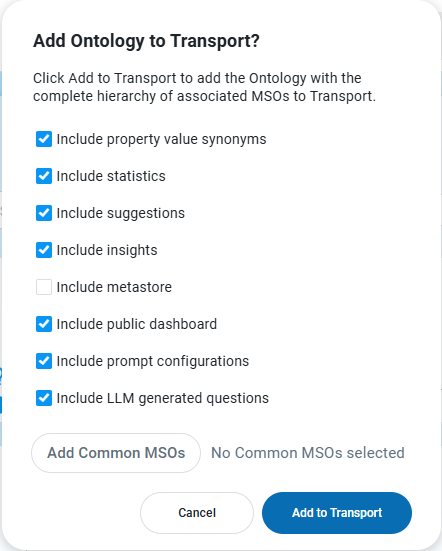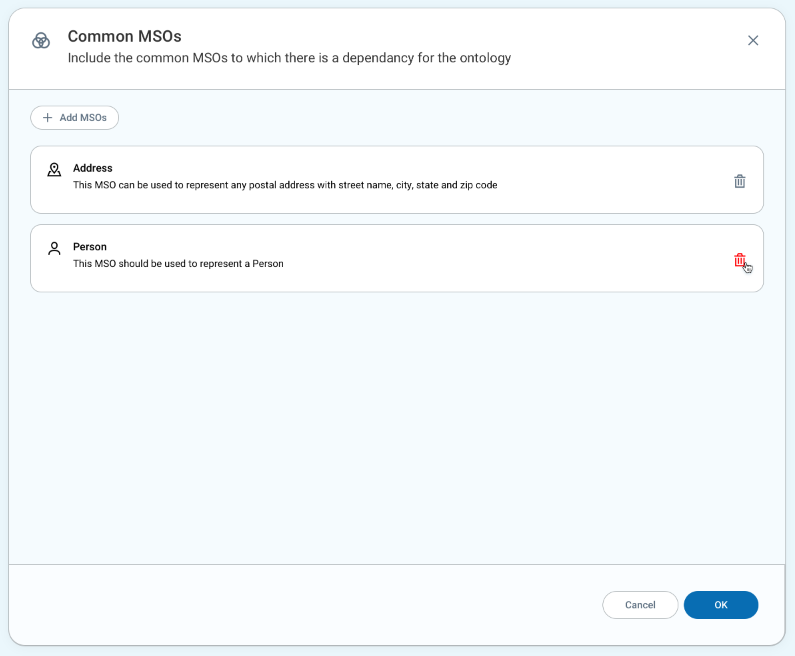Intended audience: Developers Administrators
AO Platform: 4.3
Overview
The purpose of adding an Ontology to Transport is to allow the Ontology and most of its dependencies to be easily transferred to another server environment. Simply select the Add to Transport option in the Action menu on the Ontology card in the Ontology Composer.
In some cases it may be necessary to adjust the order of the MSOs in the Transport package relative to their dependencies. See Changing the MSO Transport Order to change the MSO Order.
Add to Transport
Once the Add to Transport option has been selected, a dialog opens to allow further selection before the Transport is created and added to the Transport Tool.
All associated MSOs and all dependencies, such as relationship MSOs, Parent MSO, Pipeline references, etc… will be included in the structure enabled for Transport. In addition, the dialog offers the following options:
-
Include property value synonyms - this checkbox allows users to include property value synonyms. Property value synonyms are typically implementation/domain-specific, so they may not be required to be transferred to another implementation.
-
Include statistics - this checkbox allows users to include statistics generated from the data sources connected to the MSOs in the Ontology. This checkbox should only be selected if the target server environment has the same data. If the target server environment has different data, eg, a production environment, then Statistics should be re-generated on the target system.
-
Include suggestions - this checkbox allows users to include suggestions generated for the Ontology based on the Discovery processes (Relationships, Words, Traits). Like with Statistics, the checkbox should only be selected if the target server environment has the same data. If the target server environment has different data, eg. a production environment, then the Discovery processes will most likely need to be re-run.
-
Include insights - this checkbox allows users to include the Insights created for the Ontology.
-
Include metastore - This feature is to export database metadata that is retrieved and stored during the discovery process (a.k.a metastore in the platform). Importing this data into another environment as part of the transport significantly improves the discovery performance when creating new MSOs, as you already have this data in the system, and the system doesn’t need to spend time fetching this information. It is especially useful in cases where the Ontology has a lot of tables and table columns.
-
Include public dashboards - this checkbox allows users to include all public dashboards created in Easy Answers solutions associated with the Ontology. Unselected by default.
-
Include prompt configurations - this checkbox allows users to include the prompt configurations that have been created for use with Easy Answers, configured for use in LLM-mode.
-
Include LLM-generated questions - this checkbox allows users to include the LLM-generated questions for individual MSOs.
-
Add Common MSOs - this button opens a dialog allowing users to add Common MSOs to the Ontology. Common MSOs are most likely already on the target server environment, but if the user has knowledge about certain Common MSOs having been updated with Synonyms or otherwise updated, such Common MSOs can be included in the Transport. Common MSOs are normally added to domain-specific MSOs (referred to as Composite MSO properties) and represent…
-
common data types, such as for number fields that represent monetary values, eg. Amount MSO.
-
Look up MSOs, such as Country, State, City, and Address MSOs.
-

-
Add Common MSOs dialog

See Transport Tool for details on the next steps.
Contact App Orchid | Disclaimer
